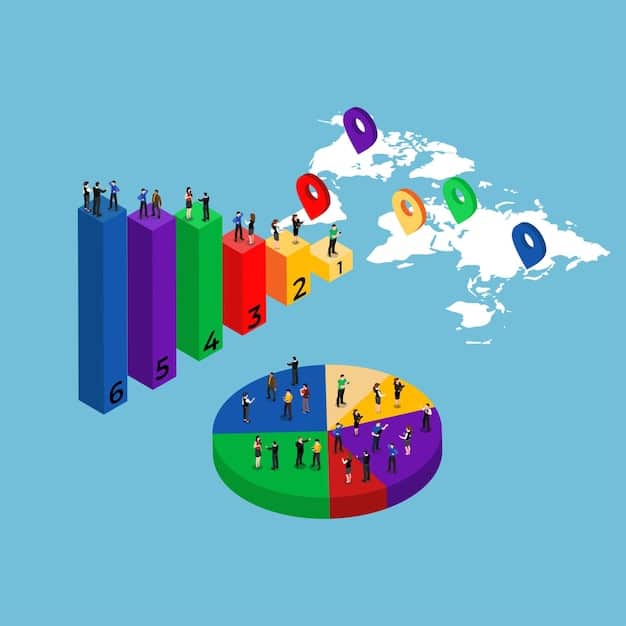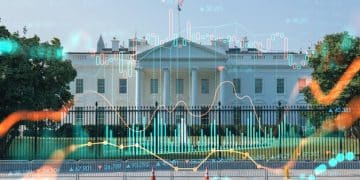2025 US Census: 5 Key Demographic Shifts & National Policy Impact

The 2025 US Census data reveals five pivotal demographic shifts impacting national policy, from an aging population and increasing diversity to changing household structures, urban-rural migration, and evolving economic patterns, necessitating adaptive governance and resource allocation strategies across various sectors.
As the United States approaches the mid-decade mark, the anticipated 2025 US Census Data: 5 Key Demographic Shifts Impacting National Policy emerges as a cornerstone for understanding the nation’s evolving fabric. This critical data collection initiative goes beyond mere numbers, offering a profound insight into the demographic currents shaping American society.
The Aging Nation: A Silver Tsunami’s Reach
The United States is undeniably growing older. This demographic shift, often coined the “silver tsunami,” is not merely a statistical anomaly but a profound transformation with far-reaching implications for nearly every aspect of national policy.
By 2025, the proportion of Americans aged 65 and over is projected to constitute an even larger segment of the national populace. This trend is driven by several factors, including increased life expectancy due to advancements in medicine and public health, coupled with lower birth rates in recent decades. The cumulative effect is a population pyramid that is broadening at its apex, creating new demands and challenges.
Healthcare and Social Security Strain
One of the most immediate and visible impacts of an aging population is on the healthcare system. An older demographic typically requires more specialized medical care, higher rates of chronic disease management, and increased demand for long-term care facilities. This places considerable strain on existing infrastructure, workforce capacity, and financial resources.
- Increased demand for geriatric specialists and home healthcare services.
- Rising costs associated with Medicare and Medicaid.
- Need for innovative approaches to preventative care and healthy aging.
Furthermore, the fiscal solvency of social security and pension systems becomes a critical concern. With a larger retiree base and a comparatively smaller working-age population contributing to these funds, the intergenerational contract faces unprecedented pressure. Policymakers are tasked with finding sustainable solutions that do not unduly burden future generations.
Economic Implications and Workforce Changes
An aging workforce also brings about shifts in labor markets. While experienced older workers contribute invaluable knowledge and skills, their retirement can lead to labor shortages in critical sectors. This necessitates strategies for workforce development, re-skilling, and potentially revising retirement policies to encourage longer careers for those able and willing to work.
The consumer market, too, adapts to older demographics. There’s an expanding market for products and services tailored to seniors, from accessible housing and transportation to leisure activities and adaptive technologies. Understanding these evolving consumer patterns is crucial for businesses and economic planning. The financial services industry, for instance, sees increased demand for retirement planning and wealth management as individuals navigate longer post-work lives.
In essence, the aging of the U.S. population is not just a trend; it’s a fundamental restructuring. It calls for comprehensive policy responses that span healthcare, economic planning, social welfare, and urban development, ensuring that communities are equipped to support and thrive amidst these demographic realities.

Increasing Diversity: A Mosaic of Identities
The United States continues its trajectory as a profoundly diverse nation, and the 2025 Census data is expected to underscore this truth with even greater clarity. This increasing diversity is far more than a simple demographic count; it represents a vibrant, evolving mosaic of cultures, languages, and perspectives that reshape the nation’s identity and policy landscape.
The growth in minority populations, particularly Hispanic and Asian communities, alongside a projected decline in the percentage of the non-Hispanic white population, fundamentally alters political, economic, and social dynamics. This shift has roots in varying birth rates among ethnic groups and sustained immigration patterns, both authorized and unauthorized.
Political Realignments and Representation
The changing racial and ethnic composition of the electorate has significant political implications. As minority groups become a larger proportion of the voting public, their collective voice in elections and policy debates grows stronger. This can lead to reconfigurations of political power, influence electoral outcomes, and necessitate new approaches to voter engagement and representation.
- Greater emphasis on policies addressing racial equity and social justice.
- Shifts in electoral maps and political party platforms.
- Increased demand for diverse representation in all levels of government.
In municipal and state governments, the impact is often felt first, as local officials grapple with the immediate needs and aspirations of their increasingly diverse constituents. From language access services to culturally competent public outreach, the demands for inclusive governance grow with demographic change.
Economic Contributions and Social Integration
Diverse populations are powerful drivers of economic growth and innovation. Immigrant communities, in particular, often exhibit higher rates of entrepreneurship and contribute significantly to the labor force, filling critical gaps in various industries. Their cultural contributions also enrich American society, fostering new culinary traditions, art forms, and community practices.
However, increased diversity also highlights existing disparities and creates new challenges related to social integration. Issues such as language barriers, discrimination, and unequal access to education and economic opportunities become more pronounced. Policies aimed at fostering inclusivity, promoting equitable access, and addressing systemic biases are vital to harness the full potential of a diverse nation. The role of education in bridging cultural gaps and preparing a diverse workforce for future challenges cannot be overstated.
Understanding and responding to this demographic shift requires a nuanced approach, moving beyond simplistic narratives to embrace the complex interplay of demographics, culture, and power. It calls for policies that not only recognize diversity but actively cultivate an environment where all identities can flourish.
Evolving Household Structures: Beyond the Traditional Family
The traditional nuclear family, while still a significant component of American society, is no longer the sole or even dominant household structure. The 2025 Census data will likely reinforce this trend, revealing a continued diversification of living arrangements that profoundly influences housing, social services, and economic policy.
Contemporary households are increasingly characterized by single-person households, cohabiting couples, single-parent families, multi-generational living arrangements, and non-family households. These shifts reflect a combination of later marriage ages, changing social norms, economic pressures, and an aging population.
Housing Market Adjustments
The diversification of household types directly impacts housing demand and supply. The rise of single-person households and smaller family units, for example, increases the need for smaller, more affordable living spaces, such as apartments and smaller townhouses. Conversely, multi-generational living, often driven by economic necessity or cultural preference, requires larger homes or structures with accessory dwelling units (ADUs).
- Increased demand for affordable housing options across diverse sizes.
- Growth in specialized housing for seniors and single adults.
- Policy incentives for multi-generational housing solutions.
Urban planning and zoning laws must adapt to these evolving needs. Policies that restrict high-density housing or prohibit ADUs may become increasingly outmoded, hindering the development of communities that effectively serve their populations. The demand for flexible, adaptable housing solutions is growing, pressing developers and policymakers alike.
Impact on Social Services and Economic Models
Different household structures also present unique challenges and opportunities for social service provisions. Single-parent families often require more robust childcare support and flexible work policies. Multi-generational households can provide built-in care networks but may also need assistance with intergenerational conflicts or shared resource management.
Economically, consumer patterns shift. Traditional models based on the nuclear family may miss significant segments of the market. Marketing strategies, product development, and even tax policies need to acknowledge this broader spectrum of living arrangements. For instance, benefits structures for families might need reevaluation to ensure they are inclusive of all household types.
The continued evolution of household structures necessitates a re-thinking of what “family” means in a policy context. It requires governments and communities to develop adaptable frameworks that support the varied ways Americans choose to live, ensuring social welfare and economic stability for all configurations.

Urban-Rural Migration and Regional Disparities
The dynamic interplay between urban, suburban, and rural areas continues to shape the geographic distribution of the U.S. population. The 2025 Census data is expected to highlight ongoing patterns of urban concentration, suburban expansion, and, in some cases, rural depopulation or revitalization. These movements exacerbate or alleviate regional disparities and necessitate tailored policy responses.
Factors influencing these migrations are varied, including job opportunities, cost of living, quality of life preferences, and the rise of remote work. The COVID-19 pandemic, for example, accelerated some movements away from dense urban centers, though the long-term impact on overall trends remains to be fully seen.
Infrastructure and Resource Allocation Challenges
Continued growth in urban and suburban areas places immense pressure on existing infrastructure, from transportation systems and utilities to schools and healthcare facilities. Investments in public transit, affordable housing, and expanded public services become critical to prevent congestion, maintain quality of life, and ensure equitable access.
- Increased need for public transportation and smart city solutions.
- Challenges in water management and energy supply for growing areas.
- Pressure on existing educational and healthcare facilities.
Conversely, rural areas experiencing population decline face the challenge of maintaining essential services with a shrinking tax base. This can lead to school closures, reduced access to healthcare, and a decline in local businesses. Policies focused on rural development, broadband expansion, and incentives for economic diversification are crucial to prevent these communities from being left behind.
Political and Social Divides
The geographic sorting of populations along urban-rural lines often correlates with political and social divides. Urban centers tend to lean more liberal, while rural areas often remain more conservative. These differences can lead to divergent priorities in policy-making, from environmental regulations to social welfare programs. Understanding these demographic concentrations is essential for effective governance and bridging ideological gaps.
The challenges of regional disparities also extend to economic opportunity. Policies aimed at fostering economic development must consider the unique strengths and needs of different regions. This includes supporting local industries, investing in infrastructure that connects rural areas to larger markets, and promoting equitable educational opportunities across all geographic contexts. Addressing these shifts requires a strategic national vision.
Evolving Economic Patterns: The New American Dream
Beyond simple population counts, the 2025 Census data will offer crucial insights into the evolving economic landscape of the United States. Shifting employment sectors, the gig economy’s growth, wealth inequality, and changing patterns of consumer spending all shape the “new American dream” and demand innovative policy approaches.
The transition from a manufacturing-heavy economy to one dominated by services and technology continues. This shift has profound implications for workforce development, income distribution, and the types of economic opportunities available to different demographic groups.
Workforce Development and Future of Work
The rapid pace of technological change necessitates continuous adaptation in the workforce. Policies must prioritize education and training programs that equip workers with the skills needed for emerging industries, such as AI, renewable energy, and advanced manufacturing. Lifelong learning initiatives and accessible vocational training become more critical than ever.
- Investment in STEM education and digital literacy.
- Support for reskilling and upskilling programs for displaced workers.
- Development of policies addressing the unique challenges of the gig economy.
The rise of the gig economy, characterized by temporary, flexible jobs, also poses regulatory challenges. Issues around worker benefits, labor protections, and fair compensation for independent contractors require careful consideration to ensure economic security for a growing segment of the workforce.
Wealth Inequality and Social Mobility
The Census data will likely highlight persistent or widening wealth inequality, a critical concern impacting social cohesion and economic stability. Policies aimed at addressing this include progressive taxation, investments in affordable education, and initiatives to promote asset building for lower and middle-income families.
Furthermore, understanding patterns of social mobility is crucial. Are individuals able to move upwards economically, or are opportunities increasingly stratified by birth or circumstance? Data on income, education, and housing will provide key indicators. Policies fostering equitable access to quality education, healthcare, and financial services are vital for ensuring that the American dream remains attainable for all citizens, regardless of their background.
Ultimately, the evolving economic patterns require a holistic policy response that supports a dynamic and inclusive economy. It’s about more than just generating jobs; it’s about creating a sustainable economic future where prosperity is widely shared, and opportunities for advancement are accessible to everyone, across all demographic groups.
Policy Agendas Shaped by Demographic Realities
The wealth of information gleaned from the 2025 US Census Data: 5 Key Demographic Shifts Impacting National Policy is not merely an academic exercise. It serves as an indispensable compass for policymakers at local, state, and federal levels, guiding crucial decisions across a myriad of domains. The intricate shifts in population dynamics, racial and ethnic composition, household structures, and geographic distribution collectively paint a picture of an America in constant flux, demanding adaptive and visionary governance.
Firstly, the aging of the population necessitates a fundamental reevaluation of healthcare financing, elder care infrastructure, and retirement security. Proactive measures, rather than reactive ones, are essential to prevent future crises related to healthcare capacity and social security solvency. This includes exploring innovative models for long-term care and incentivizing healthy aging.
Secondly, increasing diversity calls for expanded efforts in cultural competence across public services, equitable access to opportunities, and robust anti-discrimination policies. Ensuring that all citizens, regardless of their background, can participate fully in civic and economic life is paramount. Language access services, targeted educational support, and initiatives to promote inclusivity in civic institutions are key components.
Thirdly, the diversification of household structures requires flexibility in housing policies, social welfare programs, and community planning. Policies should move beyond a one-size-fits-all approach, recognizing the varied living arrangements and support needs of modern American families. This includes adapting zoning for diverse housing types and ensuring social services are accessible to all family configurations.
Fourthly, the patterns of urban-rural migration necessitate a dual approach: robust investment in resilient urban infrastructure and strategic revitalization efforts for rural communities. Bridging the digital divide, fostering regional economic partnerships, and addressing infrastructure gaps in both growing and declining areas are critical for national cohesion and economic balance.
Finally, evolving economic patterns require a sustained focus on workforce preparedness for the future and addressing wealth inequality. This involves investing heavily in education and skills training, adapting labor laws to the gig economy, and implementing policies that promote broad-based economic prosperity. Policies should aim to safeguard workers’ rights and ensure fair compensation in an evolving labor market, fostering innovation while ensuring social safety nets.
These demographic shifts present both formidable challenges and immense opportunities. By meticulously analyzing the 2025 Census data, policymakers can develop evidence-based strategies that foster an inclusive, resilient, and prosperous future for all Americans. The true value of this census lies in its capacity to inform and inspire proactive, equitable policy-making tailored to the real-world experiences of a changing nation.
| Key Shift | Brief Impact |
|---|---|
| 👵 Aging Nation | Strains healthcare, social security, and alters labor markets. |
| 🌍 Increasing Diversity | Redraws political landscapes and enriches national identity, demanding inclusive policies. |
| 🏡 Evolving Households | Transforms housing demand and necessitates flexible social services. |
| 🏙️↔️ Rural-Urban Migration | Creates infrastructure challenges and regional development disparities. |
Frequently Asked Questions About the 2025 US Census and Policy
The 2025 US Census data provides an essential snapshot of the nation’s population, offering detailed insights into demographic shifts. This information is vital for governmental planning, resource allocation, and policy formulation across various sectors like healthcare, education, and infrastructure, ensuring decisions align with current societal needs and trends.
An aging population significantly increases demands on healthcare systems, requiring more resources for chronic disease management, specialized geriatric care, and long-term services. Policy must adapt through funding reforms for Medicare and Medicaid, promoting preventative health, and investing in new models of elder care to ensure sustainability and quality.
Increasing diversity demands social policies that prioritize inclusivity, equitable access to opportunities, and combat discrimination. This includes language access in public services, culturally sensitive education programs, and initiatives to ensure fair representation and participation of all ethnic and racial groups in civic life.
The diversification of household structures, including more single-person and multi-generational homes, requires housing policies to be more flexible. This means promoting diverse housing types like smaller apartments or accessory dwelling units, adapting zoning laws, and fostering affordable housing solutions that cater to varied family sizes and economic circumstances.
To address evolving economic patterns, policies must focus on workforce development, continuous education, and fair labor practices for the growing gig economy. Investments in reskilling programs, STEM education, and frameworks that ensure worker benefits and protections for independent contractors are crucial for a resilient and equitable future.
Conclusion
The 2025 US Census data stands as a critical barometer, capturing the profound demographic shifts shaping the American landscape. From an increasingly older and diverse population to evolving household structures, intricate urban-rural migrations, and dynamic economic patterns, these trends are not mere statistics; they are fundamental forces reshaping national policy. Understanding and proactively responding to these shifts is paramount for ensuring equitable healthcare, robust social security, inclusive communities, and a resilient economy. The insights from this census will undoubtedly serve as the bedrock for crafting policies that address current challenges and foster a more prosperous and adaptable future for all Americans, emphasizing the continuous need for informed, data-driven decisions in governance.





